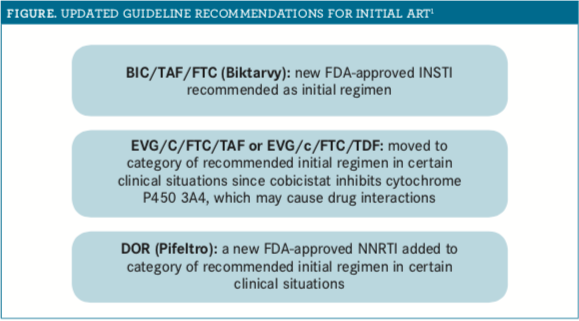Publication
Article
Pharmacy Practice in Focus: Health Systems
HIV Treatments and Guidelines Offer More Options
Author(s):
Case reports of sustained HIV-1 remission, new drug approvals, and resistance testing provide patients with potential novel therapy approaches.
There are a variety of treatment options available for HIV through antiretroviral therapy (ART). Adherence to ART is extremely important to ultimately reduce the viral load to an undetectable level, and medication adherence can reduce the risk of patients developing drug resistance.
Pharmacists are key in managing patients with HIV and educating them about treatment. New ART options were recently approved, offering more choices in the case of drug resistance or treatment failure. Also, the HIV treatment guidelines now contain more information about resis- tance testing and update initial ART treatment recommendations from October 25, 2018.
HIV GUIDELINE UPDATES
The guidelines from the US Department of Health & Human Services include new recommendations for initial ART based on drug approvals and drug interactions (figure).1 Also, there are updated warnings regarding dolutegravir (DTG) and the risk of neural tube defects.1,2 Preliminary data from an ongoing observational study suggest that there is an increased risk of neural tube defects in infants born to women taking DTG at conception.2 Based on these recent data, the HIV guidelines now recommend that DTG not be used as treatment for patients who are pregnant and within 12 weeks post conception and those planning to become pregnant, unless there are no alternatives.1
NEW DRUG APPROVALS
There were 3 new drugs approved in 2018 to treat HIV virus type 1 (HIV-1): bictegravir, emtricitabine, tenofovir alafenamide (Biktarvy, Gilead Sciences, Inc), doravirine (Pifeltro, Merck), and ibalizumab-uiyk (Trogarzo, Theratechnologies).
Trogarzo is classified as an orphan drug and the first in a new class, monoclonal antibodies approved for use in combination with other antiretrovirals in patients with a multidrug-resistant infection.3 Trogarzo is administered intravenously every 2 weeks. The most common adverse effects include diarrhea, dizziness, nausea, and rash. Drug interaction studies have not been conducted with Trogarzo. However, drug interactions are not expected based on the mechanism of action. Immune reconstitution inflammatory syndrome has been reported in patients receiving combination ART, which can worsen pre-existing infections.3 Pharmacists should counsel patients to be vigilant and notify their health care providers if they experience any signs of infection. In a recent phase 3 study, Trogarzo was evaluated in patients with multidrug-resistant HIV-1 infection in whom ARTs have failed.4 The study found that 83% of patients had a significant decrease in viral load (P <.001).4

The dosage of Biktarvy is 1 tablet daily, and it should be avoided in patients with a creatinine clearance below 30 mL/ min and in patients with severe hepatic impairment.5 Dofetilide (Tikosyn), rifampin, and St. John’s wort should be avoided with Biktarvy, as there are drug interactions. Biktarvy also carries a boxed warning for risk of worsening of hepatitis B infection. Pharmacists should educate patients that Biktarvy should be taken 2 hours before antacids.5
Pifeltro is a non-nucleoside reverse transcriptase inhibitor that is used in combination with other ARTs, and the dosage is 1 tablet daily.6 Increase this to 1 tablet twice a day when it is used in combination with rifabutin (Mycobutin). Because of drug interactions, Pifeltro is contraindicated with the following medications: carbamazepine, enzalutamide, mitotane, oxcarbazepine, phenobarbital, phenytoin, and St. John’s wort. The most common adverse drug reactions include abdominal pain, abnormal dreams, diarrhea, dizziness, fatigue, headache, and nausea.6
HIV REMISSION CASES
Two patients with HIV are in remission and essentially cured after experimental surgery involving bone marrow transplant using stem cells and chemotherapy.7,8 Both of these patients had cancer. A third patient, who also had cancer, received similar treatment, and specialists are monitoring the individual before confirming that he is cured.7 This could be a revolutionary discovery, but there are risks involved. Future research is necessary, as the procedure has been conducted only on patients with cancer and HIV.
Jennifer Gershman, PharmD, CPh, is a drug information pharmacist and Pharmacy Times®contributor who resides in South Florida.
REFERENCES
- Department of Health and Human Services Panel on Antiretroviral Guidelines for Adults and Adolescents. Guidelines for the use of antiretroviral agents in adults and adolescents living with HIV. AIDSinfo website. aidsinfo.nih.gov/ contentfiles/lvguidelines/adultandadolescentgl.pdf. Published October 25, 2018. Accessed March 11, 2019.
- FDA drug safety communication: FDA to evaluate potential risk of neural tube birth defects with HIV medicine dolutegravir (Juluca, Tivicay, Triumeq). FDA website. www.fda.gov/Drugs/DrugSafety/ucm608112.htm. Updated September 6, 2018. Accessed March 12, 2019.
- Trogarzo [prescribing information]. Irvine, CA; TaiMed Biologics USA Corp; 2018. www.accessdata.fda.gov/drugsatfda_docs/label/2018/761065lbl.pdf. Accessed March 11, 2019.
- Emu B, Fessel J, Schrader S, et al. Phase 3 study of ibalizumab for mul- tidrug-resistant HIV-1. N Engl J Med. 2018;379(7):645-654. doi: 10.1056/ NEJMoa1711460.
- Biktarvy [prescribing information]. Foster City, CA; Gilead Sciences, Inc; 2018. gilead.com/~/media/files/pdfs/medicines/hiv/biktarvy/biktarvy_pi.pdf. Accessed March 11, 2019.
- Pifeltro [prescribing information]. Whitehouse Station, NJ; Merck & Co, Inc; 2018. merck.com/product/usa/pi_circulars/p/pifeltro/pifeltro_pi.pdf. Accessed March 11, 2019.
- O’Donnell J, Alltucker K. Doctors might have found a cure for HIV. But is it worse than the disease? USA Today. March 8, 2019. usatoday.com/story/news/ health/2019/03/08/hiv-aids-cure-stem-cell-bone-marrow-transplant-london-pa- tient/3083976002/. Accessed March 12, 2019.
- Gupta RK, Abdul-Jawad S, McCoy LE, et al. HIV-1 remission following CCR5Δ32/Δ32 haematopoietic stem-cell transplantation. Nature. 2019. doi: 10.1038/s41586-019-1027-4.







